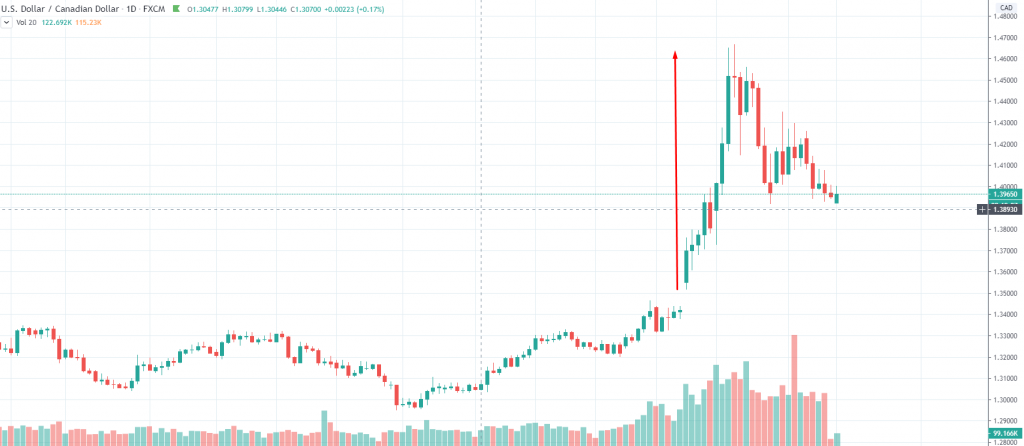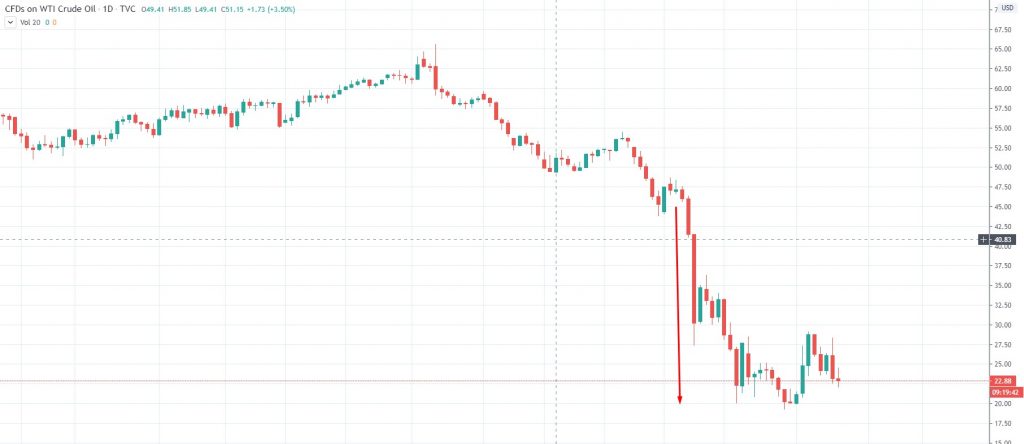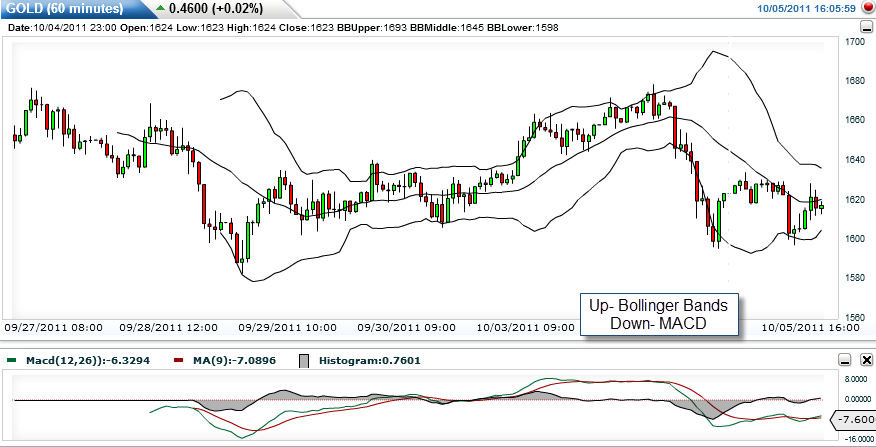In Chapter 11 – Forex in Relation to Stocks and Commodities and Trading with MetaTrader you will learn about the relationship between stocks, indices, and commodities to the forex market. In addition, you will learn how to master the MetaTrader platform.
- Stocks, Forex and Commodities – Long relationship…
- Forex Signals – Following market alerts
- What not to do
- Master the world of Forex: “MetaTrader”
Stocks, Forex and Commodities – Long Relationship
Be honest. You didn’t really think that there was no relation between the Forex market, stocks and commodities, right? Of course they are related. There is a strong interaction between these three markets. The Canadian Dollar is highly correlated to oil prices, since Canada contains the third largest oil reserves in the world. Look at the charts below… when oil goes up, USD/CAD goes down during the trading session on Monday, 13 April 2020. USD/CAD declined  While WTI (West Texas Intermediate) oil surged
While WTI (West Texas Intermediate) oil surged  Let’s try to understand these relations: when a certain market exchange, in NY, London or any other market rallies, it used to mean that the economy in this particular market is growing. It obviously has implications – more external investors from other countries want to enter this market and invest in a growing economy which opens up new potential horizons. It leads to more intense usage of the national currency, and to increased demand for the currency as a result. This is how Forex comes into the picture! That used to be the story until the 2008 global financial crisis. Now, things have distorted a little. It just means that there is more monetary or fiscal stimulus coming up, such as a decline in the interest rates. That means that more cheap money will be around in the real economy, so obviously, some of this money ends up on stocks, therefore the indices of the stock markets go up. That has been the story from these last eight years. The biggest and most influential stock markets in the world:
Let’s try to understand these relations: when a certain market exchange, in NY, London or any other market rallies, it used to mean that the economy in this particular market is growing. It obviously has implications – more external investors from other countries want to enter this market and invest in a growing economy which opens up new potential horizons. It leads to more intense usage of the national currency, and to increased demand for the currency as a result. This is how Forex comes into the picture! That used to be the story until the 2008 global financial crisis. Now, things have distorted a little. It just means that there is more monetary or fiscal stimulus coming up, such as a decline in the interest rates. That means that more cheap money will be around in the real economy, so obviously, some of this money ends up on stocks, therefore the indices of the stock markets go up. That has been the story from these last eight years. The biggest and most influential stock markets in the world:
| Stock Market | Description |
| DOW USA | One of the two premier stock indexes in the U.S.A., The Dow Jones Industrial Average measures the trading performances of the top 30 publicly traded companies. The DOW is highly influenced by market sentiment, economic and political events. Players: McDonald’s, Intel, AT&T, etc… |
| NASDAQ USA | The largest electronic trading market in the U.S. with approximately 3,700 electronic listings. The NASDAQ has the largest trading volume among the stock markets of the world. Players: Apple, Microsoft, Amazon, etc… |
| S&P500 USA | Its full name is the Standard & Poor 500. An index of the 500 largest American companies. Considered as a good barometer for the American economy. The S&P500 is the second most traded index in the U.S. after the Dow. |
| DAX Germany | Germany’s stock market index. Consists of the top 30 stocks traded on the Frankfurt Stock Exchange. The DAX is the most traded index in the Eurozone, being the most popular index in Europe. This is no surprise, given that Germany is the largest economy in the Eurozone. Key players: BMW, Deutsche Bank, etc… |
| Nikkei Japan | Reflects the overall market conditions in Japan by tracking the top 225 companies in the Japanese market. Key players: Fuji, Toyota, etc… |
| FTSE (“Footsie”) UK | The Footsie index tracks the performance of the most highly valued UK companies listed on the London Stock Exchange. As in other markets, there are a few versions, depending on the size of the index (FTSE 100 for example). |
| DJ EURO STOXX 50 Europe | The Eurozone’s leading index. Its full name is the Dow Jones Euro Stoxx 50 index. Tracks 50 top stocks from 12 euro member countries |
| Hang Seng Hong Kong | Hong Kong’s stock market index. Tracks the performance of the Hong Kong stock market by monitoring the price changes of the overall stocks included in this index. Organized by Hang Seng Bank’s HIS services. |
In many cases, the American and Japanese stock market exchanges behave similarly. The performance of one strongly reflects on the other. The performance of the DAX tends to closely match the performance of the EUR. We can predict trends in the EUR according to the general direction of the DAX. As mentioned above, the more money in the economy the higher the value of indices and, obviously, the cheaper the currency. So, the correlation between the currencies and the respective stock indexes is close to -1 as of 2016 – almost perfect negative correlation. Trading commodities on your platforms: Many platforms allow you to also trade commodities like oil, gold, and silver. If you are interested in trading commodities there are several things you should keep in mind: Goods and commodities are traded according to the stability of the local and global markets. To see this for yourself check out what happened to the price of Gas during the revolutions of the Arab Spring at the beginning of 2011 – prices rose to new historical records! If you want to trade commodities it is really important to follow major events around the world and to do some fundamental analysis! Events can have a major impact on the prices of these goods. Another event? Oil prices hit rock bottom during several months at the beginning of 2016. The reason? The global economy has been slowing down since 2014. In early 2016, two more events added fuel to the fire; the US economy has led the recovery but having difficulties due to the winter season (among other reasons), and the Chinese stock market was rapidly losing value. The consequence? The market felt that the oil demand would decrease and everyone accelerated selling oil. It reached below $30/barrel in early 2016. Example: Gold is protected from inflation. Therefore, when concern about rising inflation in a specific market occurs, gold often gets stronger! Likewise, gold and silver are highly influenced by political instability. If South Africa is having political problems, gold’s price would probably rise dramatically (South Africa is a major gold exporter). But fundamental analysis isn’t enough. That is why we also use technical indicators. The use of such indicators for the goods and commodities markets is identical to their use in the Forex market. You should know that strategies like Swing, Breakouts, Day Trading, etc. apply to these markets also. The value of certain commodities, such as precious metals, occasionally rises when other large markets lose value. For example, in the last decade, while both the global economy and most major currencies have weakened, more and more traders have turned to commodities investments, which means a negative correlation between the commodities and the indexes is formed. But not for long. That lasted until the US economy and the rest of the global economy began the second downturn in a decade. The demand for commodities fell, so the correlation between the global economy and commodities turned positive again. As soon as you heard negative news from a large global economy, the commodities would drop like a stone, apart from gold which is a safe haven commodity. Important: The average length of trends in commodities markets are usually much longer than in Forex markets. As a result, trading these goods can offer a great long-term investment. Rallies are often long and massive. Therefore, when a trend breaks, it probably indicates a long-term change is coming our way. You can use technical indicators like Fibonacci, RSI and the rest to help spot these trends. Gold charts look like this:  The high liquidity of the gold chart makes it an attractive investment alternative, even for intraday trades. Many traders from all over the world have discovered the commodities markets through their trading platforms. These markets have become ever more popular during the last few years, for several reasons: massive volume and high volatility thanks to a range of events which have had a huge impact on these markets; simplicity and convenience of the brokers’ platforms; more educated traders; and the numerous headlines that these have grabbed in the media. These recommended brokers offer full services for commodities trading with excellent terms.
The high liquidity of the gold chart makes it an attractive investment alternative, even for intraday trades. Many traders from all over the world have discovered the commodities markets through their trading platforms. These markets have become ever more popular during the last few years, for several reasons: massive volume and high volatility thanks to a range of events which have had a huge impact on these markets; simplicity and convenience of the brokers’ platforms; more educated traders; and the numerous headlines that these have grabbed in the media. These recommended brokers offer full services for commodities trading with excellent terms.